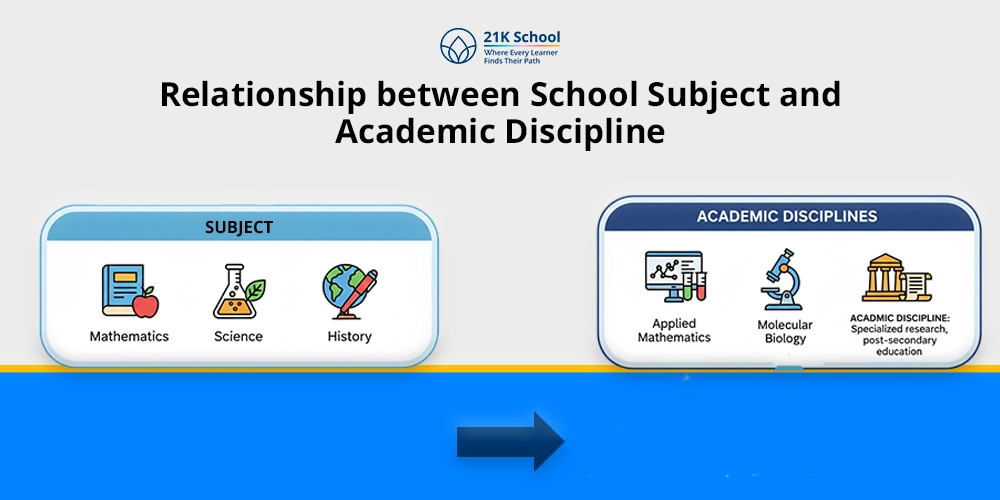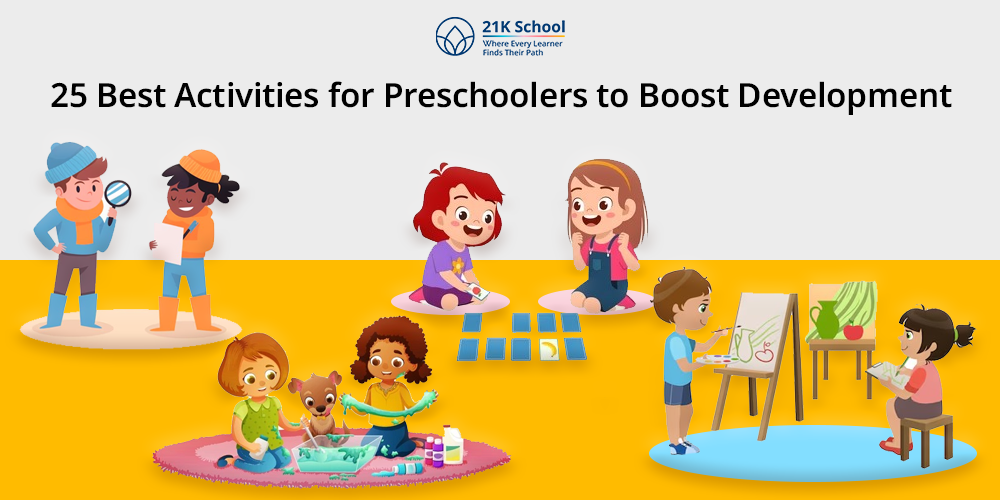
The students at the preschool stage are full of life and energy, inquisitiveness, and imagination. It is during these early years that the brain is developing, the social bonding takes place, as well as emotional learning.
How to nurture these areas in the best way? Play-based activities. Well-thought games and crafts are both entertaining and develop aspects of problem-solving, body coordination, empathy, and language in young children.
As a parent, a teacher or a nanny, it is a must to have a list of new, and interesting activities for the kids. Go through homeschooling preschoolers: fun and educational activities. So that education can be fun and successful.
Listed here are 25 fun and learning activities with lots of playfulness and little learning. Just the way it should be with a preschooler.
Contents
- 25 Best Activities for Preschoolers to Boost Early Learning
- 1. Ice-Melting Fun
- 2. Art and Crafts
- 3. Letter-Memory Game
- 4. Slime
- 5. Scavenger Hunt
- 6. Filled Squares
- 7. Play Dough
- 8. Pom-Poms and Golf Tees
- 9. Feelings Games
- 10. Language Play
- 11. Sticker Activities
- 12. Spaghetti Broom Paintings
- 13. Handprint Art
- 14. Farm-Themed Yoga
- 15. Desert Pizzas
- 16. Body Bridges
- 17. Sorting Box Play
- 18. Letter Crafts
- 19. Invitations to Play
- 20. Matching Pairs Memory Game
- 21. Pinecone Owls
- 22. Completing Drawing Prompts with Crafts
- 23. Kick the Cup
- 24. Rhyming with Blocks
- 25. Symmetry with Lego Blocks
- Concluding Thoughts
25 Best Activities for Preschoolers to Boost Early Learning
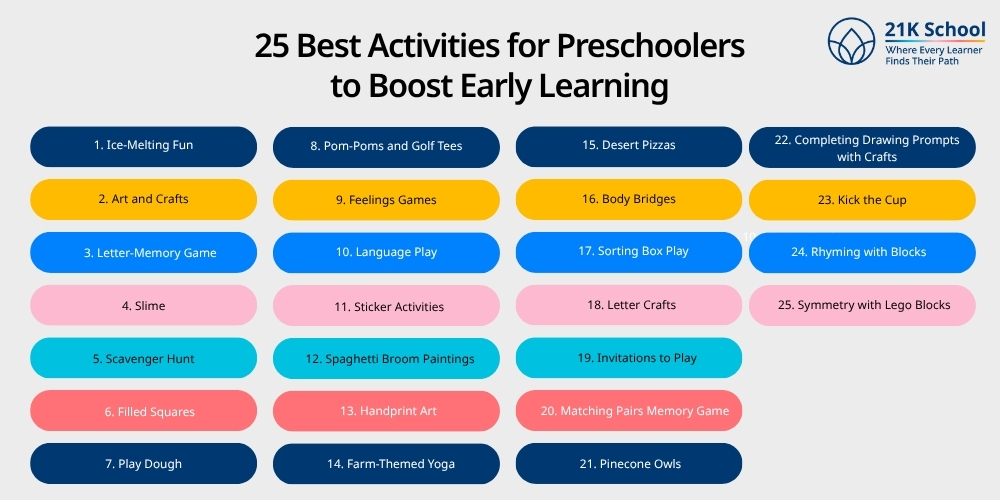
At the age of 3-5 years, children are known to have their most brain development. This is the right age to introduce them to the world in a manner that stays with them forever.
And this can be done through activities which are fun and engaging.
1. Ice-Melting Fun
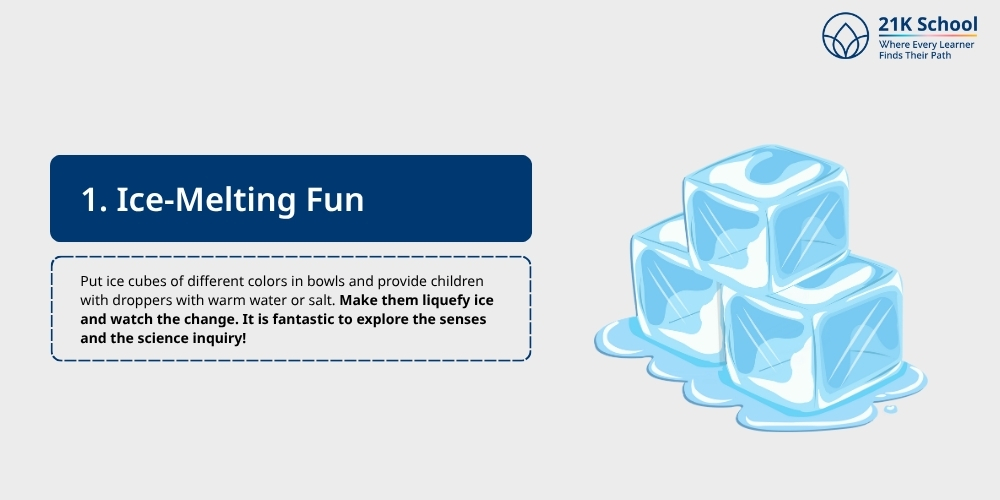
Put ice cubes of different colors in bowls and provide children with droppers with warm water or salt. Make them liquefy ice and watch the change. It is fantastic to explore the senses and the science inquiry!
- Skills acquired: Control of fine motor skills, observation, patience.
- Required Materials: colored ice cubes, bowls, droppers, salt and warm water.
- How to Do It: Put colored ice cubes into the bowls. Salt on top or pleasant-tasting water is given to children in droppers that are warm. Allow them to see how it is melted.
- Bonus Tip: Also prepare glitter or small toys to put on the ice to have a surprise.
2. Art and Crafts
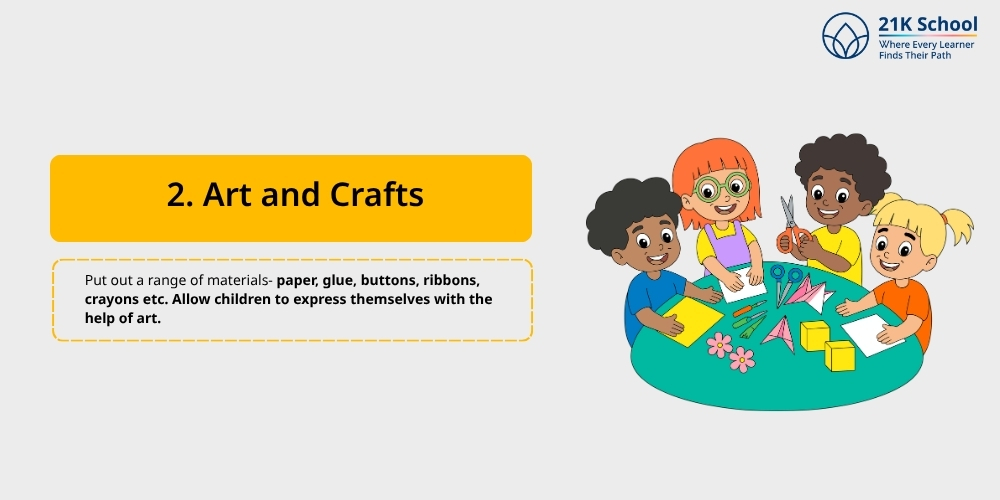
Put out a range of materials- paper, glue, buttons, ribbons, crayons etc. Allow children to express themselves with the help of art.
- Skills learned: Creativity, color recognition, hand eye coordination.
- Materials Required: paper, glue, crayons, stickers, buttons and ribbons.
- How to Do It: Prepare a table with a variety of art materials and allow children to develop unique art pieces.
- Bonus Hint: To create ideas, be willing to introduce a theme, e.g. Underwater World or Space.
Explore more creative art and craft ideas for kids by reading the blog from here.
3. Letter-Memory Game
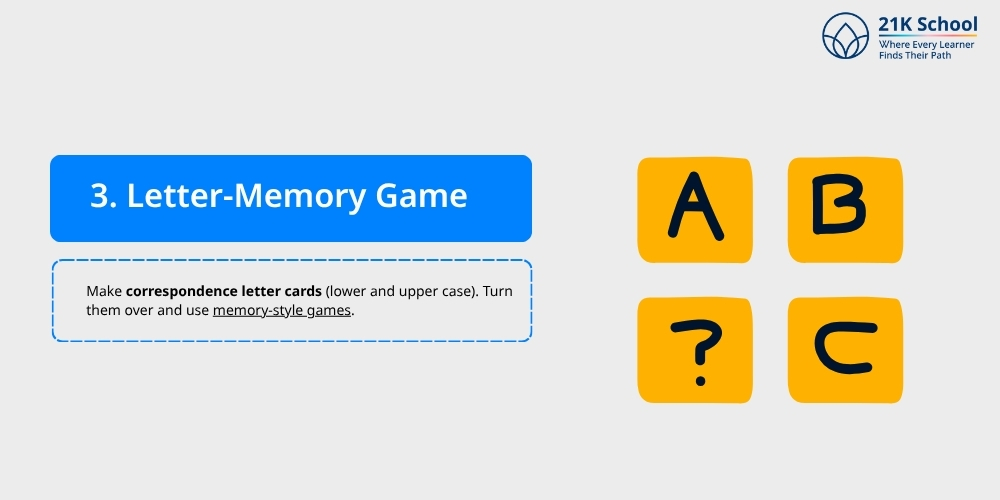
Make correspondence letter cards (lower and upper case). Turn them over and use memory-style games.
- Skills acquired: Memory, recognition of alphabets.
- Materials Needed: Cards having lower and upper cases.
- How to Do it: Lay cards face down. Children slide off two at a time trying to get matching pictures.
- Extra Advice: Make use of pictures cards (e.g. A is for apple) to increase interaction.
4. Slime
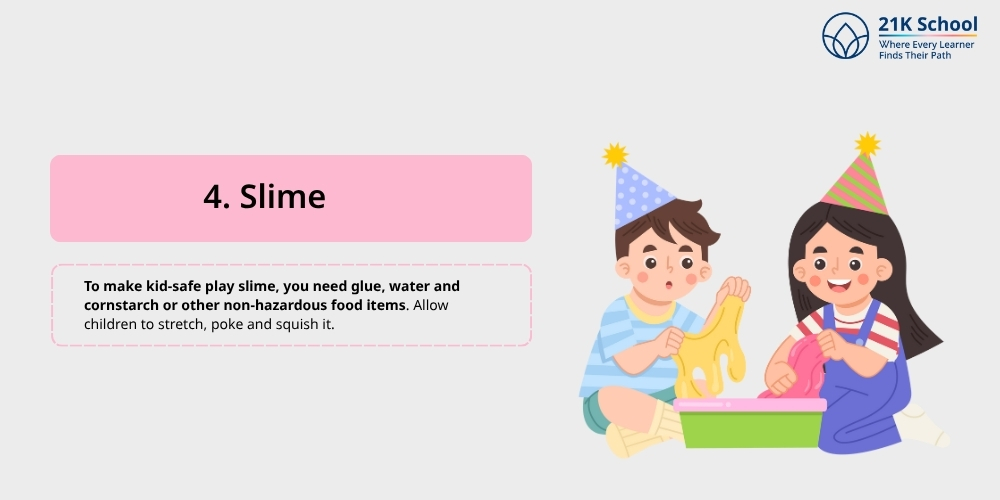
To make kid-safe play slime, you need glue, water and cornstarch or other non-hazardous food items. Allow children to stretch, poke and squish it.
- Skills acquired: Sensory awareness and science exploration.
- Needed Materials: Glue, water, cornstarch or safe slime activator, Food coloring.
- How to Do It: Blend the ingredients until the slime is obtained. Allow children to pull, pinch and touch things.
- Bonus Tip: Use some glitter or bead of sensory twist.
5. Scavenger Hunt
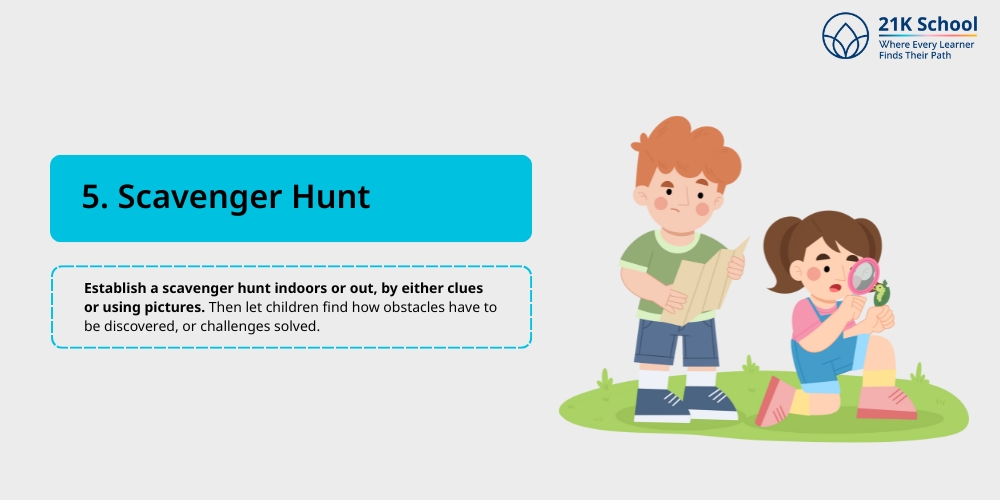
Establish a scavenger hunt indoors or out, by either clues or using pictures. Then let children find how obstacles have to be discovered, or challenges solved.
- Acquisition of skills: Problem solving, vocabulary, team production.
- Materials Needed: Hide and seek objects/cards that can be printed or basket/bag.
- How to Do It: Conceal objects in the house/ classroom. Provide hints, or visual clues.
- Bonus Tip: Pick a theme such as colors, animals or shapes.
6. Filled Squares
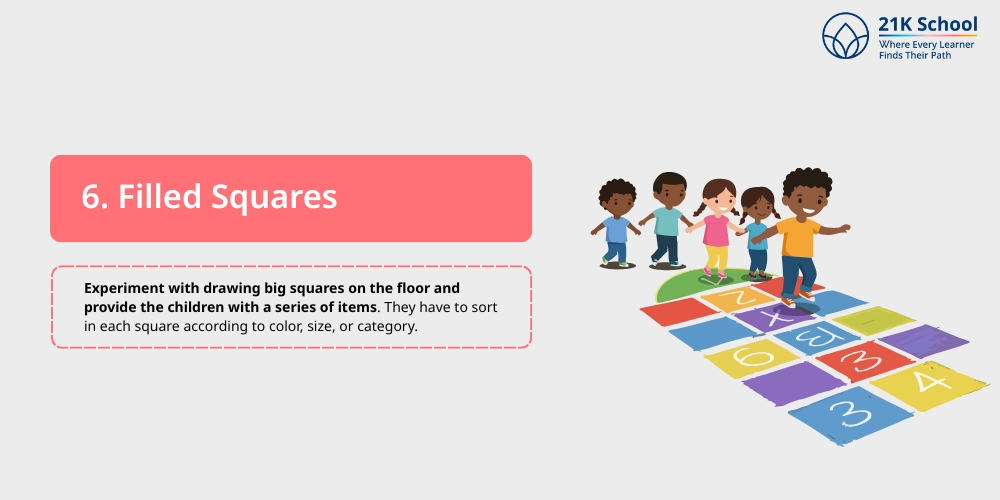
Experiment with drawing big squares on the floor and provide the children with a series of items. They have to sort in each square according to color, size, or category.
- Skills acquired: Classification, sorting, space awareness.
- Materials Needed: Square of Floor tape, colored objects or toys.
- How to Do It: Kids put the items in color- or category-designated squares.
- Bonus Tip: Set a time limit to make the activity interesting.
7. Play Dough
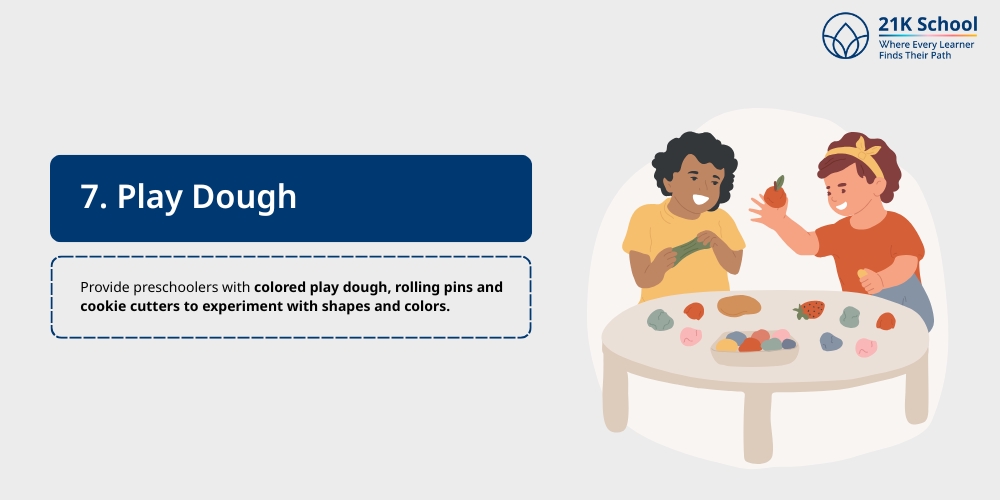
Provide preschoolers with colored play dough, rolling pins and cookie cutters to experiment with shapes and colors.
- Skills acquired: Creativity, recognition of shape, fine motor skill.
- Materials needed: All color play dough, cookie cutters, rolling pin.
- How to Do It: Children may make shapes, objects or even letters by hand.
- Bonus Tip: Create your own scented playdough.
8. Pom-Poms and Golf Tees
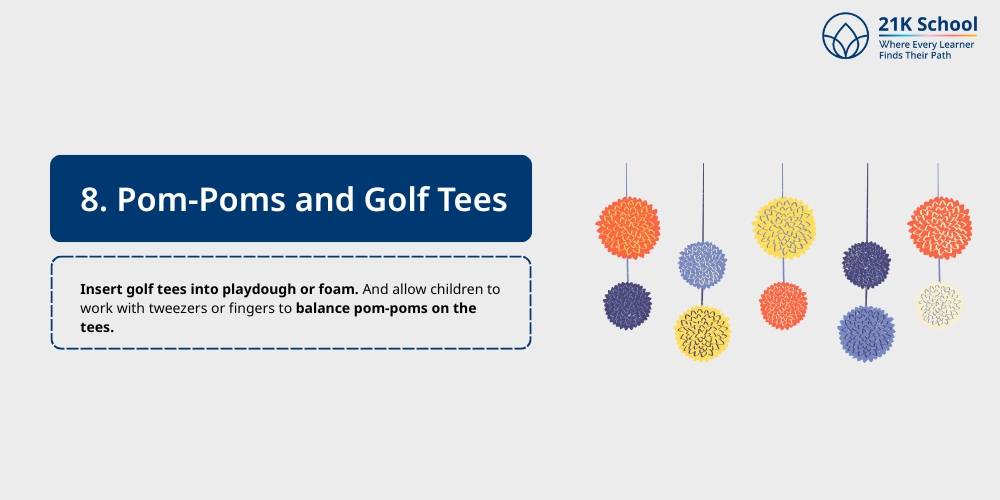
Insert golf tees into playdough or foam. And allow children to work with tweezers or fingers to balance pom-poms on the tees.
- Skills acquired: Focus, accuracy, and body coordination.
- Materials Required: a foam block or play dough, golf tees, pom-poms, tweezers.
- How to do it: Drive push tees into foam. Pom-poms can be balanced with tweezers on top.
- Bonus Tip: To make it more challenging, transform it into a relay game.
9. Feelings Games
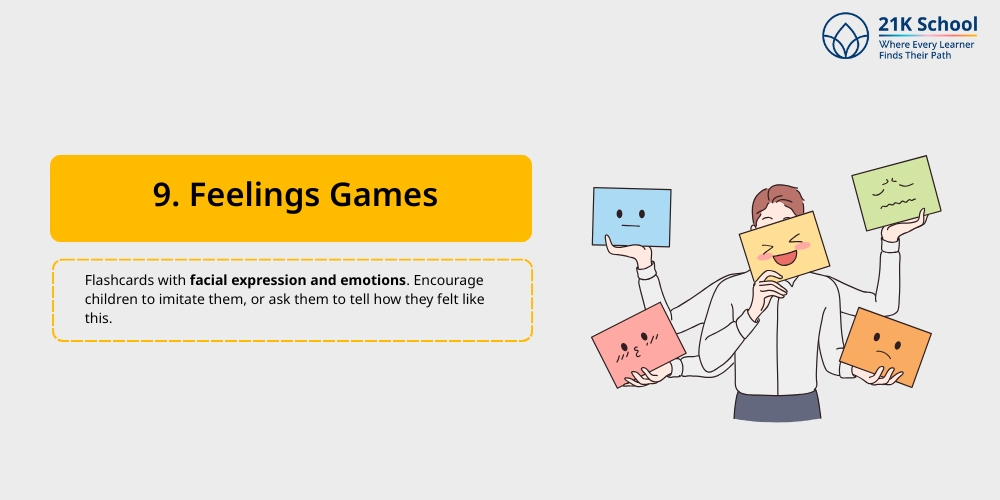
Flashcards with facial expression and emotions. Encourage children to imitate them, or ask them to tell how they felt like this.
- Skills learned: Emotion intelligence, empathy, expression.
- Materials Required: Flashcards, emotion emotions or mirrors.
- How to Do It: Express an emotion and tell kids to repeat it or tell a story when they were like that.
- Bonus Tip: Discussing feelings in a more comfortable way on the use of the puppet.
10. Language Play
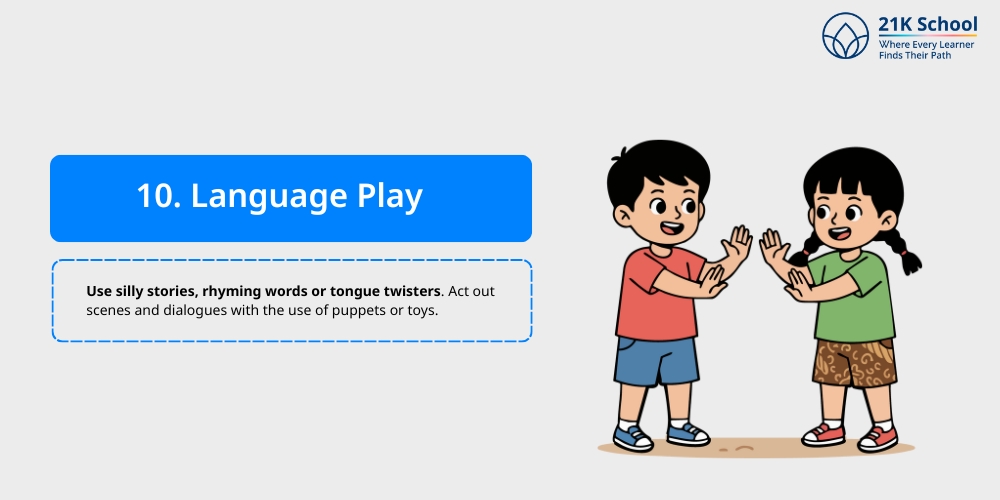
Use silly stories, rhyming words or tongue twisters. Act out scenes and dialogues with the use of puppets or toys.
- Skills acquired: vocabulary, verbal fluency, listening skills.
- Materials required: Rhyming cards, storybooks, and puppets are required.
- How to Do: Puppets, rhymes, and songs are to be used in order to promote conversation.
- Bonus Idea: Make kids make their own goofy rhymes.
11. Sticker Activities
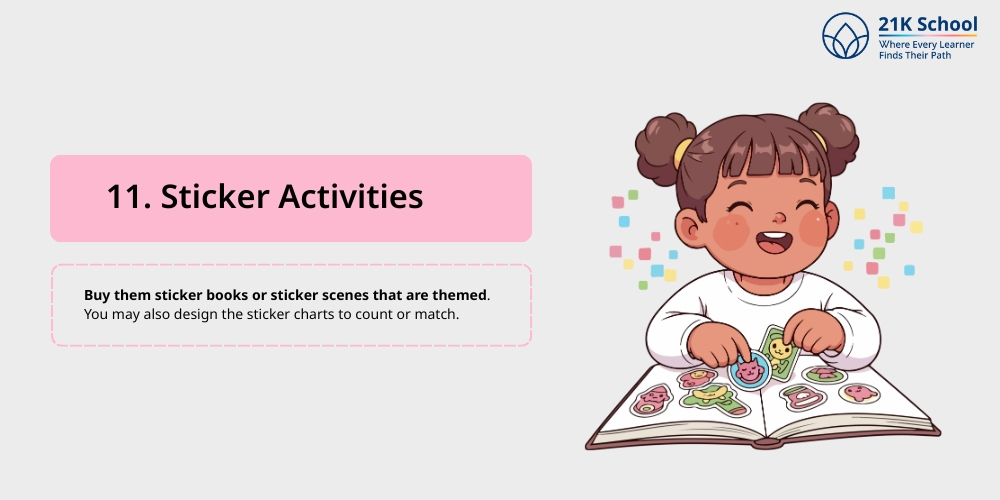
Buy them sticker books or sticker scenes that are themed. You may also design the sticker charts to count or match.
- Skills attained: Pincer grasp, planning skills, tracking.
- Materials needed: Theme sticker books, chart paper.
- How to Do It: Children fill in pictures or do their own paintings by using stickers.
- Bonus Tip: Teach first, next and last using stickers.
12. Spaghetti Broom Paintings
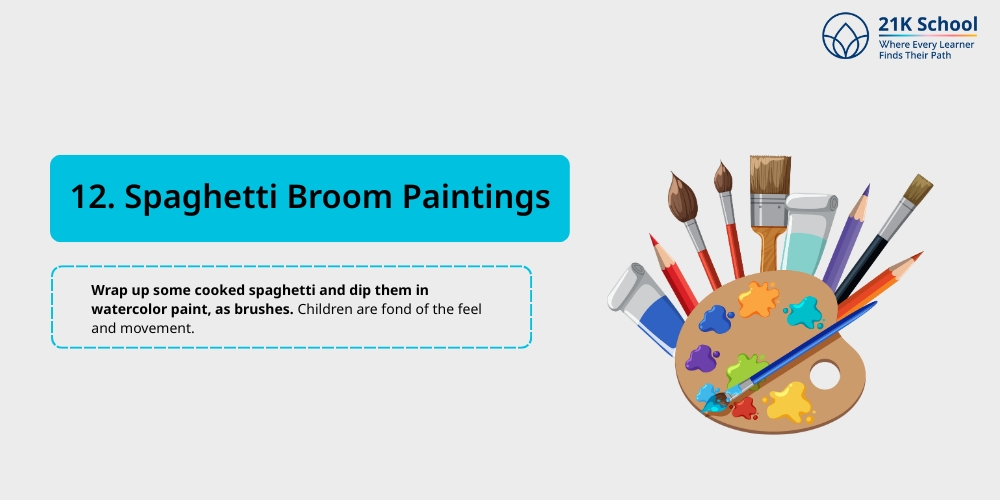
Wrap up some cooked spaghetti and dip them in watercolor paint, as brushes. Children are fond of the feel and movement.
- Learned skills: Sensory-based play, creative exploration with arts, fine motor skill.
- Materials needed: Cooked spaghetti, rubber bands, paint, paper.
- How to Do It: Interlace some spaghetti into a broom. Put the paper into paint and dab.
- Bonus Tip: Vary in lengths to have a variation in texture.
13. Handprint Art
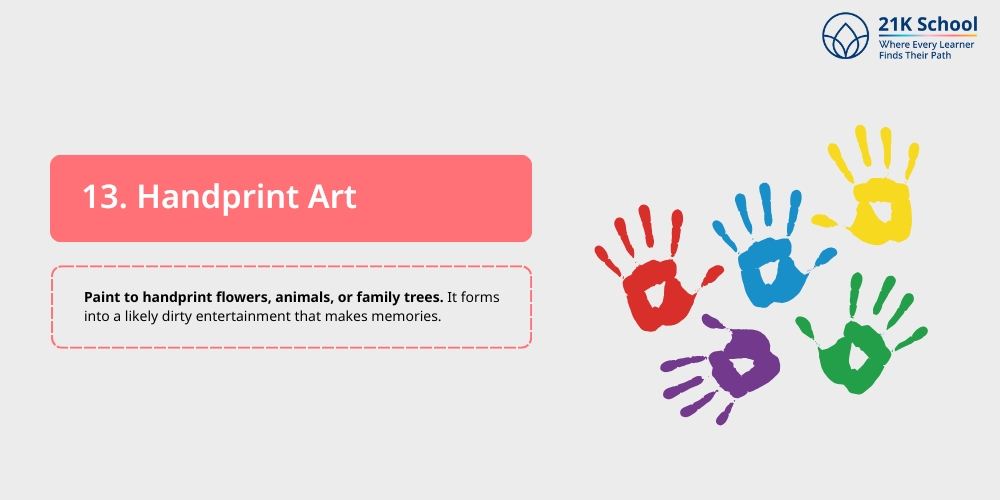
Paint to handprint flowers, animals, or family trees. It forms into a likely dirty entertainment that makes memories.
- Skills built: Self awareness, dexterity, imagination.
- Materials Needed: Paint, paper, clean up wipes.
- How to Do It: Children should dab hands in paint and print out. Change them to flowers, animals, etc.
- Bonus Tip: Put in a poem or story to make it individual.
Also Read, 14 Best Engaging Self- Awareness Activities For Students
14. Farm-Themed Yoga
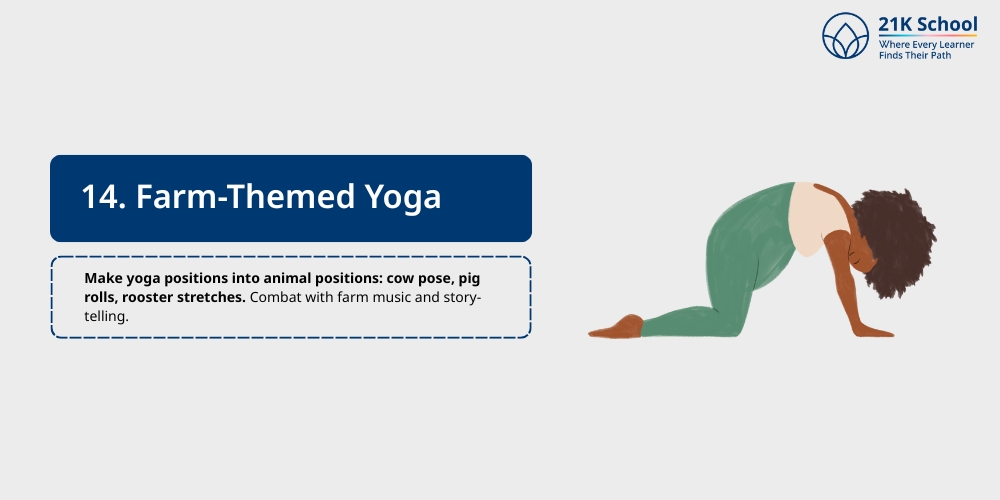
Make yoga positions into animal positions: cow pose, pig rolls, rooster stretches. Combat with farm music and story-telling.
- Skills acquired: Coordination, body-awareness, listening.
- Materials Needed: Clear room, yoga mats (if you want), animal flashcards.
- How to Do It: Each time you show animal cards and imitate poses (cow, dog, cat, rooster).
- Bonus Advice: Put animal sounds in the background.
15. Desert Pizzas
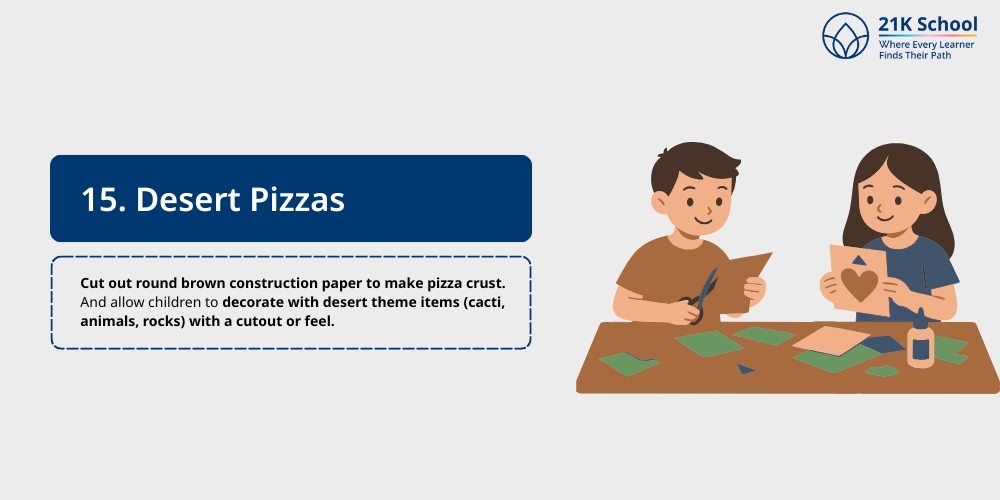
Cut out round brown construction paper to make pizza crust. And allow children to decorate with desert theme items (cacti, animals, rocks) with a cutout or feel.
- Accomplished skills: Thematic learning, geography awareness, design.
- Materials Required: Brown paper circles, craft items (felt, foam cut-outs, glue).
- How to Do It: Decorate “pizzas” with desert-themed items like cactus cutouts, sun shapes, etc.
- Bonus Tip: Introduce a desert story beforehand.
16. Body Bridges
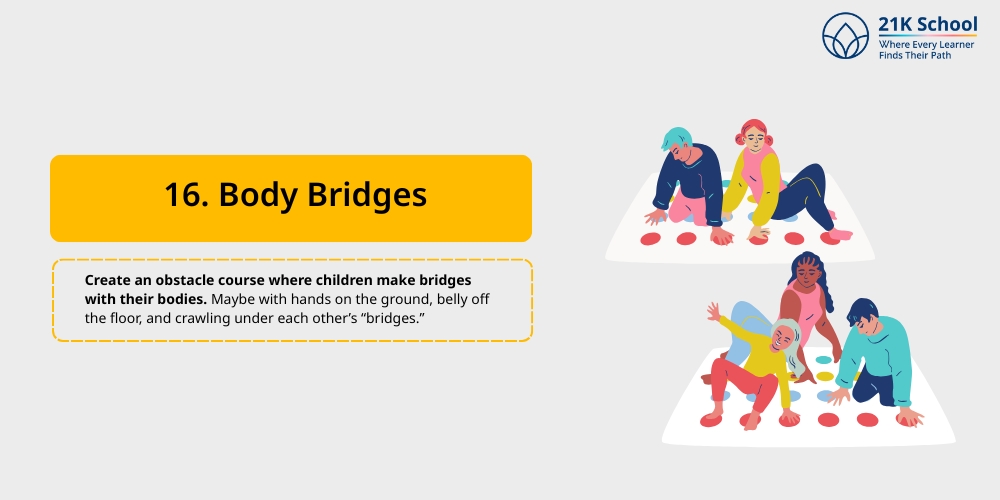
Create an obstacle course where children make bridges with their bodies. Maybe with hands on the ground, belly off the floor, and crawling under each other’s “bridges.”
- Skills developed: Strength, balance, cooperative play.
- Materials Required: Open floor space.
- How to Do It: Children create bridges with their bodies and crawl under each other.
- Bonus Tip: Add music for a musical-bridge twist.
17. Sorting Box Play
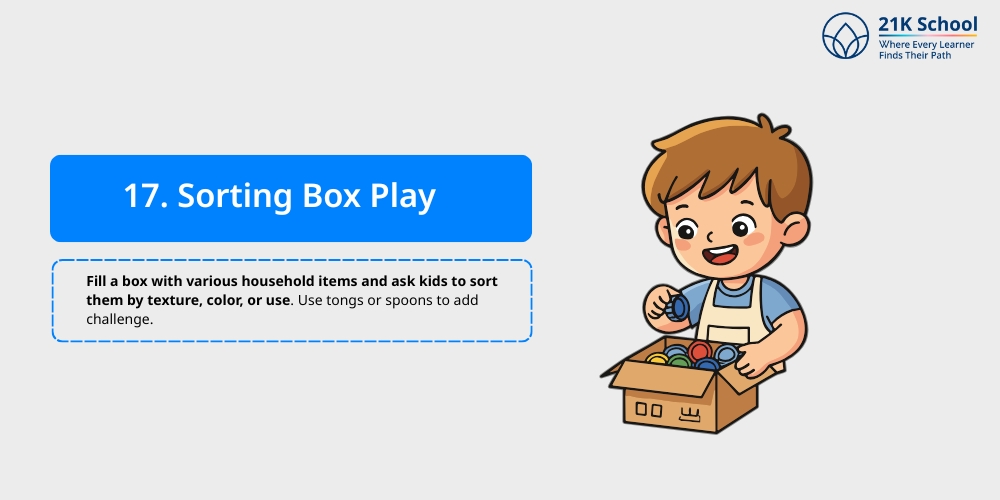
Fill a box with various household items and ask kids to sort them by texture, color, or use. Use tongs or spoons to add challenge.
- Skills developed: Cognitive sorting, classification, vocabulary.
- Materials Required: Large box, small mixed items (buttons, leaves, toys), sorting trays.
- How to Do It: Ask children to sort by texture, color, or shape.
- Bonus Tip: Introduce tongs or spoons to increase difficulty.
18. Letter Crafts
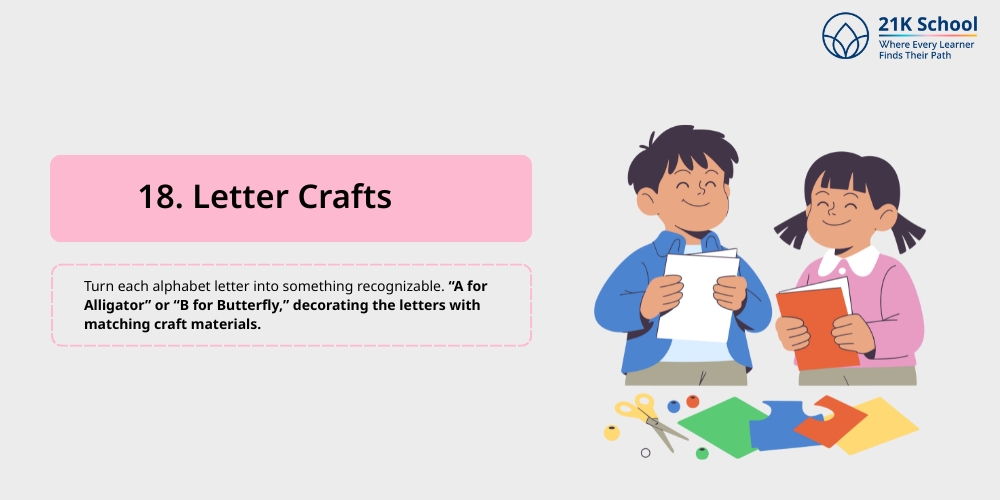
Turn each alphabet letter into something recognizable. “A for Alligator” or “B for Butterfly,” decorating the letters with matching craft materials.
- Skills developed: Alphabet familiarity, creativity, associations.
- Materials Required: Cardboard letters, themed decorations.
- How to Do It: Decorate each letter with materials matching its sound (e.g., cotton for C).
- Bonus Tip: Create an alphabet wall.
19. Invitations to Play
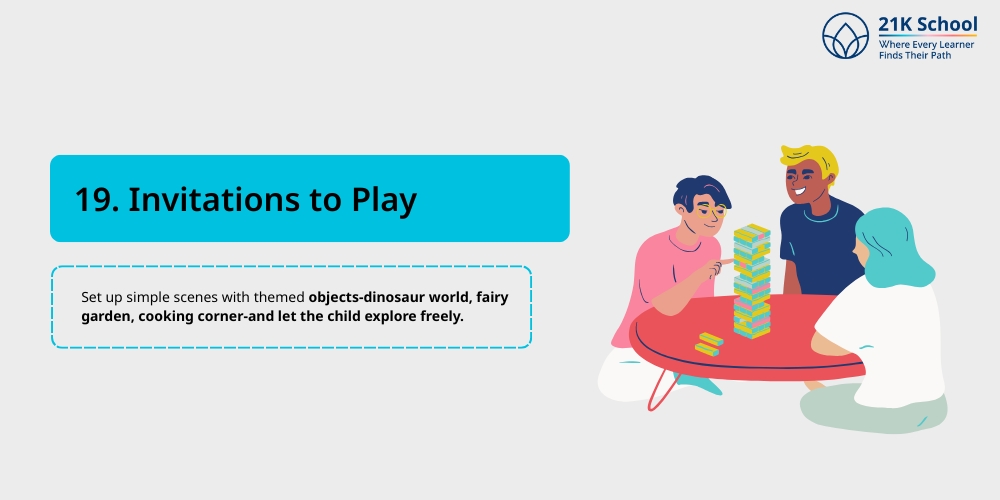
Set up simple scenes with themed objects-dinosaur world, fairy garden, cooking corner-and let the child explore freely.
- Skills developed: Imaginative play, narrative building, autonomy.
- Materials Required: Themed small-world play setups (e.g., mini farm, construction site).
- How to Do It: Set up scenes and let children explore freely.
- Bonus Tip: Include storybooks related to the scene.
20. Matching Pairs Memory Game
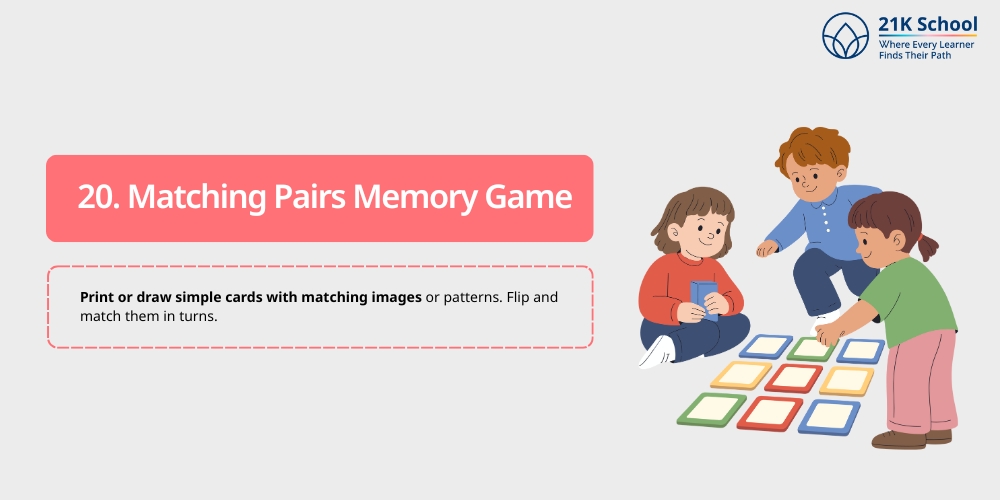
Print or draw simple cards with matching images or patterns. Flip and match them in turns.
- Skills developed: Memory, focus, pattern recognition.
- Materials Required: Cards with matching images or shapes.
- How to Do It: Place all cards face down and flip to find pairs.
- Bonus Tip: Use family photos for a personal twist.
21. Pinecone Owls
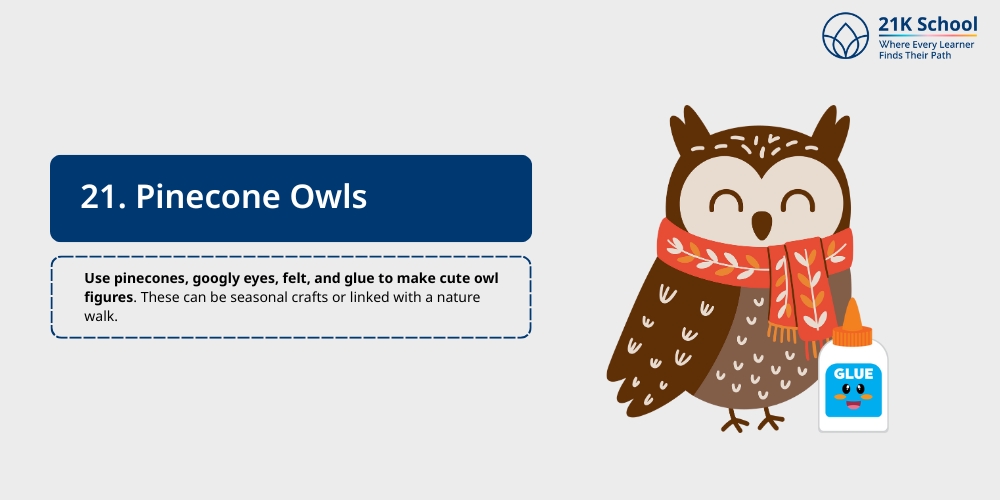
Use pinecones, googly eyes, felt, and glue to make cute owl figures. These can be seasonal crafts or linked with a nature walk.
- Skills developed: Crafting skills, nature connection, creativity.
- Materials Required: Pinecones, googly eyes, felt, glue.
- How to Do It: Attach eyes, wings, and beaks to pinecones to make owls.
- Bonus Tip: Use as decorations for fall or nature themes.
22. Completing Drawing Prompts with Crafts
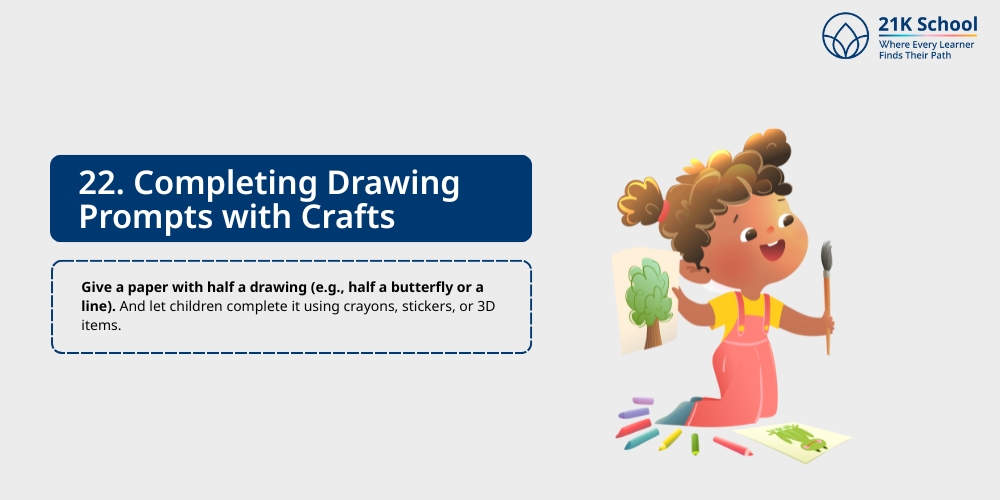
Give a paper with half a drawing (e.g., half a butterfly or a line). And let children complete it using crayons, stickers, or 3D items.
- Skills developed: Symmetry, fine motor skills, artistic expression.
- Materials Required: Half-finished drawings on paper, crayons, glue, craft items.
- How to Do It: Children complete the drawing using their own imagination.
- Bonus Tip: Display the art in a “gallery” wall.
23. Kick the Cup
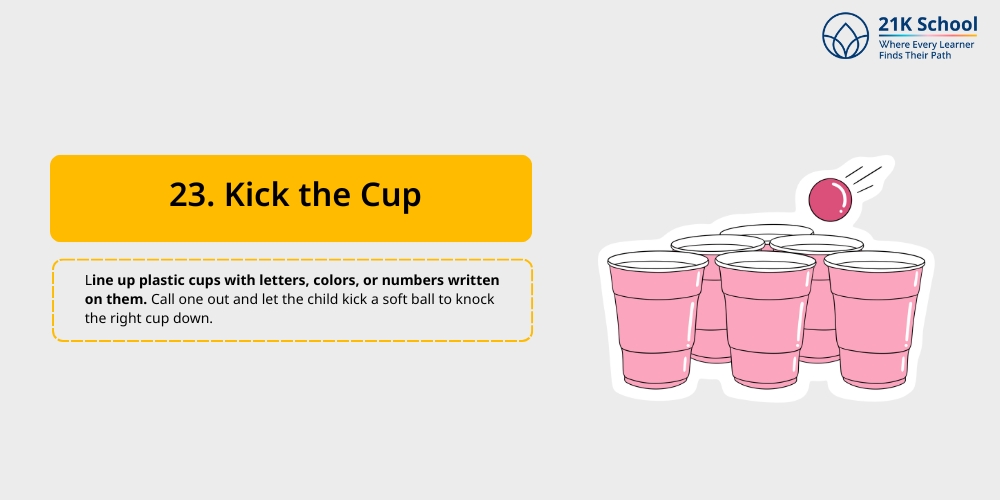
Line up plastic cups with letters, colors, or numbers written on them. Call one out and let the child kick a soft ball to knock the right cup down.
- Skills developed: Gross motor skills, target accuracy, active learning.
- Materials Required: Plastic cups, soft ball, marker.
- How to Do It: Label cups with numbers or letters. Call out a cup and let the child kick the ball to knock it over.
- Bonus Tip: Use a scoring chart for added motivation.
24. Rhyming with Blocks
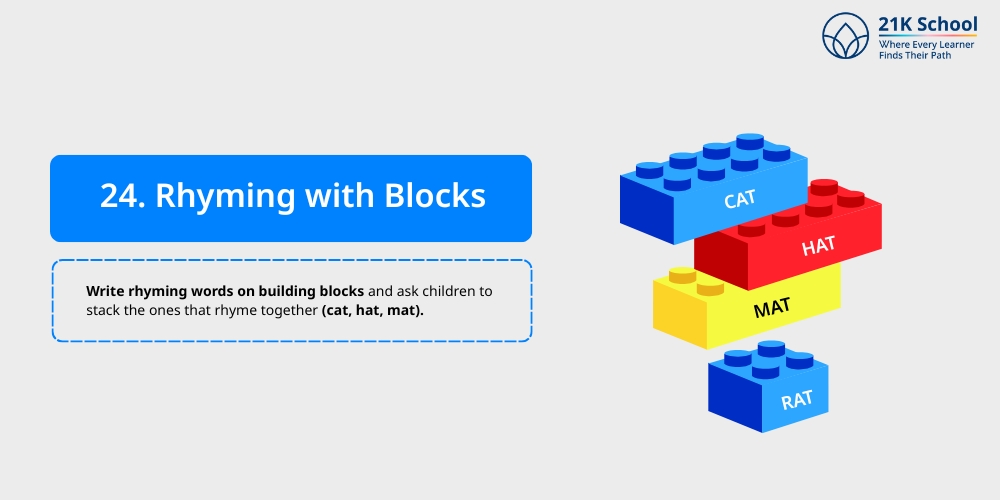
Write rhyming words on building blocks and ask children to stack the ones that rhyme together (cat, hat, mat).
- Skills developed: Phonemic awareness, reading readiness, matching.
- Materials Required: Building blocks with word stickers.
- How to Do It: Kids stack rhyming word blocks together.
- Bonus Tip: Add a “nonsense word” column for laughs.
25. Symmetry with Lego Blocks
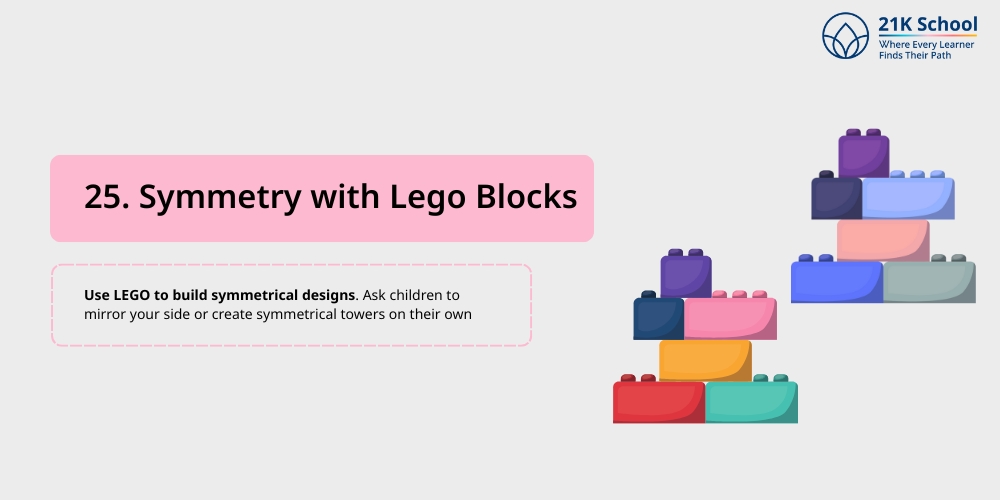
Use LEGO to build symmetrical designs. Ask children to mirror your side or create symmetrical towers on their own.
- Skills developed: Math skills, spatial intelligence, symmetry awareness.
- Materials Required: LEGO pieces, base plates.
- How to Do It: Build half a design and ask the child to complete the symmetrical side.
- Bonus Tip: Photograph creations for a class symmetry book.
Concluding Thoughts
Activities for preschoolers are much more than just entertainment. They are essential learning tools, especially for the online preschool kids. Every carefully planned game, craft, or exercise supports the child’s cognitive, social, emotional, and physical development.
These early experiences help child to shape confidence, problem-solving abilities, empathy, and communication. These are the skills that form the foundation of lifelong success.
The key to a successful preschool activity is engagement through exploration. When children are allowed to play, experiment, and create, they become joyful learners.
Whether it’s squishing slime, painting with pasta, or rhyming with blocks. Each of these 25 activities offers a unique opportunity to turn fun into learning.

